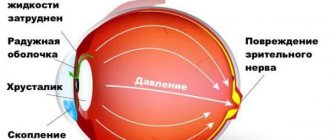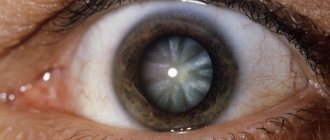Blindness can be congenital or acquired. The congenital form of the defect is explained by pathologies in certain lobes of the brain, retina or optic nerves. Most often, congenital blindness is absolute. It often appears in the absence of any defects in the formation of the organ of vision. This lack of vision is called “ amaurosis
"
Until recently, such diseases were considered incurable. But today, thanks to the possibilities of gene therapy, people who were blind from birth are beginning to see. Genetic engineers believe that it is retinal diseases that provide an opportunity to demonstrate the abilities of this branch of science. Indeed, serious progress has already been made in experiments on laboratory animals. Leber amaurosis
treatment method has been tested on volunteers and is also surprisingly effective.
The fact is that it is on the organs of vision that it is more convenient to test genetic engineering techniques. The retina is accessible for various manipulations, and its appearance makes it easy for a cell equipped with a “therapeutic gene” to penetrate the required number of cells. Researchers also already know which specific genes should be “fixed” in connection with certain vision changes.
Leber's amaurosis
- This is a fairly rare congenital disorder, which is observed in only one baby out of eighty thousand born. Changes in one of eleven genes cause changes in light-sensitive cells. The child stops seeing and does not even distinguish between light spots.
This disease has been known and studied for more than a hundred years. That's why scientists discovered all the genes responsible for amaurosis. Recent advances in genetic engineering have made it possible to introduce the necessary gene into a gene transmitter virus. The virus was introduced into the patient's tissue, and it brought the necessary information to eliminate the defect. This is the only method for introducing the desired gene into millions of cells. Thanks to the activity of the virus, this task was accomplished quite quickly. At the same time, the virus itself is completely safe, because before it was introduced into the patient’s body, it was also “processed” by genetic engineers.
Russian scientists also keep up with world science. Thus, the Institute of Neurosurgery in St. Petersburg has already carried out several fairly successful operations to treat amaurosis using stem cells.
After administering stem cells to a child with amaurosis, he began to respond better to light, began to move around the house independently, and even saw the outlines of objects. A few months after the first procedure, a repeat procedure was performed, which enabled the child to see surrounding objects blurred. When testing, in ninety percent of cases the baby correctly indicated the name of the objects.
Meanwhile, amaurosis makes it possible to develop other senses and often leads to the emergence of genius abilities. According to scientists from Canada, babies who are blind from birth have better hearing, a sense of rhythm and musical ability. The brain of such a child compensates for blindness with other abilities. Thus, people who are blind from birth are ten times easier to remember musical chords, and also sense changes in tonality.
Total blindness (absolute loss of vision in both eyes) affects only 5% of all people classified as blind. The rest experience partial visual impairment of varying degrees of severity. Many of them are barely able to distinguish the digits of a car license plate at arm's length; Some people have even more severe vision loss: they can barely distinguish between light and dark and cannot count the fingers directly in front of them. Their world is devoid of clear outlines, unsteady and illusory; with some disorders, the surroundings are seen as if through a thin tube.
Treatment
Having made an appointment with an ophthalmologist and undergone all the necessary examinations, the patient receives an individual course of treatment, which depends on the source of the problem. For example, deterioration of the visual system caused by cataracts is treated with surgery. The effects of poor nutrition are normalized by diet. Glaucoma, for example, can only be slowed down, so it is important not to wait for its terminal stage, but to start fighting the disease as early as possible. Infectious diseases are treated therapeutically.
Blindness protects against schizophrenia
: March 30, 2015, Our Arctic, volume 61, No. 1
A little-known but very interesting fact: people born blind do not have schizophrenia! At first glance, this statement does not sound very plausible and raises a lot of questions, including the main one: maybe we are talking about a simple coincidence, since there are not so many people born blind? Has no one really paid attention to this phenomenon all this time? In fact, experts have long known and studied this pattern. After all, it is she who can help us not only better understand the disease, but also perhaps find a new, unexpected way to treat schizophrenia
A little-known but very interesting fact: people born blind do not have schizophrenia! At first glance, this statement does not sound very plausible and raises a lot of questions, including the main one: maybe we are talking about a simple coincidence, since there are not so many people born blind? Has no one really paid attention to this phenomenon all this time? In fact, experts have known about it for a long time, but until now it has not come to the attention of the general public.
It is impossible to say that people born blind have a healthier psyche than most sighted people: as is known, congenital blindness does not protect against most psychiatric disorders. Moreover, people born blind are more likely to suffer from anxiety disorders, depression, anorexia nervosa and autism. But not from schizophrenia! Moreover, it is congenital blindness that “protects” from schizophrenia, as opposed to acquired blindness.
Interestingly, a congenital deficiency in one of the other senses does not “work” like that. For example, congenital deafness not only does not reduce, but according to some data even increases the likelihood of hallucinations. Moreover, among people who lost both sight and hearing in childhood, cases of schizophrenia are relatively common. In addition, it is already known that the loss of one of the six senses, and at a certain period of development, affects the manifestation of one specific psychiatric disease. This curious fact is supported by statistical studies and a small but respectable list of scientific papers (Silverstein et al.
, 2012;
Sanders et al.
, 2003).
Returning to schizophrenia, first of all we need to understand whether there is a difference between a person born blind and a person who became blind in adulthood. From a scientific and medical point of view, there is a difference, and it lies in the fact that their brains develop differently.
Unlike the nervous system of flies and crabs, the structure of the brain of vertebrates, including humans, is not written entirely in DNA. A description of all the connections of the human brain (1011 neurons and 1015 synapses!) simply would not fit in DNA (109 nitrogenous bases); our brain is too complex for this. In this sense, chromosomes contain only general rules by which neurons from some parts of the brain try to establish connections with others. Fine-tuning of nerve connections, debugging and construction of neural networks occur in the process of direct brain work, starting from the prenatal period until about the age of twenty.
In the process of “self-construction,” the brain “counts” on the arrival of various kinds of ordered information from the outside and is ready to use this information to build effective, “meaningful” neural connections. Thus, our visual cortex, located in the occipital part of the brain, “expects” that at a certain moment the eyes will begin to send it information about the world around us. In a sighted person, ordered information from the retina gradually trains cortical neurons and helps them build neural networks capable of analyzing visual information.
If this information does not come, if the eyes are “silent,” then entire areas of the cortex do not develop according to the “normal scenario.” But instead of simply shutting down or wallowing in useless inactivity, they switch to processing other types of information. As a result, the brains of people born blind, as well as people who went blind in the first months of life, will be functionally different from the brains of most people, including those who became blind in relatively adulthood. The visual cortex of people born blind is very active and “responds,” among other things, to auditory and tactile (tactile) stimuli. So, returning to our statistical fact, the emphasis on those born blind only means that one of the adaptive, compensatory changes that occur in the brains of early blind people somehow gives them “immunity” against schizophrenia.
What is the mechanism of this phenomenon? It’s difficult to say for sure, but significant details can be noted. It is likely that early blindness alters the development of a person's cognitive abilities in the opposite direction to what is observed in patients with schizophrenia (or people with a congenital predisposition to this disorder). Early blindness forces one to analyze auditory information more intensively and accurately, while patients with schizophrenia are not strong at distinguishing sound nuances. Blind people are inevitably more attentive to the “soundscape” and can follow the development of several sounds at the same time.
In addition, by the time they reach adulthood, people born blind, compared to sighted people, develop more tenacious and capacious short-term memory and can retain more information in long-term memory (which is not at all surprising if you imagine the life and daily difficulties of a blind person). In patients with schizophrenia, on the contrary, memory is weakened.
Blindness allows for both finer motor control and greater integration of proprioceptive senses (“body senses”), which, again, tend to be weakened in schizophrenia. In contrast, the “strengths” of patients with schizophrenia—the ability to think abstractly, transfer the properties of objects to broader semantic categories, play on words, and invent new words—exactly correspond to the “weaknesses” of people who were early blind.
Thus, a general picture emerges: blindness “pushes” people to develop precisely those cognitive skills and aspects of thinking that are first affected by schizophrenia or even contribute to its development. And if blindness comes early, when the brain is still quite plastic, changes in brain development, as a strange side effect, “correct” the problems characteristic of schizophrenia.
Some scientists, however, interpret this statistical fact in a more sophisticated way.
Perhaps it is not so much that blindness immerses a person in a world of sophisticated cognitive “training” for auditory acuity and depth of memory, but also how exactly the infant’s brain reacts to blindness compared to the adult’s brain. Perhaps when the visual cortex becomes involved in processing auditory and tactile information, the human brain is in some sense more stable, almost “redundant.” In a situation where in a sighted person the temporal cortex will communicate directly with the parietal or frontal cortex, in an early-blind person the same flows of information will be simultaneously processed by the visual cortex, transmitted along several parallel pathways. According to statistics, 50-70 people per 10 thousand of the population develop schizophrenia at some point in their lives.
Childhood blindness is less common: in developed countries, out of 10 thousand children, on average three are blind. But children are generally considered to be people under 18 years of age, and those born blind (in this case) can be considered those who become blind in early infancy, before about six months of age. One can roughly estimate that there are approximately 1 such people in 100 thousand. There should then be approximately 1 in every 10 million people born blind with schizophrenia. Not much, it would seem, but the world population is almost 7 billion. This means that there should be approximately 700 people born blind with schizophrenia in the world , but not a single such case has been described in the entire medical literature . Perhaps the answer lies precisely in the fact that the traditionally “strong” visual parts of the brain in primates are more deeply involved in working on a variety of “non-visual” tasks, and this “additional computational power" makes brain function more reliable.
And finally, a little about the practical semantics of the question. When it suddenly turns out that one disease leads to relief or reduction of the symptoms of another, scientists often say that “disease A protects against disease B.” But we must understand that we are talking here about a theoretical observation, and not at all about a call, say, to “infect” everyone with disease A in order to defeat disease B. Not at all! But any pattern of this nature can help us better understand both diseases, and therefore, ultimately, find ways to treat them.
For example, genes associated with sickle cell anemia are known to “protect” against malaria, and patients with systemic lupus are less likely to develop certain types of cancer. Both facts are very interesting, and their study can lead to unexpected breakthroughs in the fight against each disease. So it is in the case of the not obvious pattern that we introduced you to: perhaps someday it will make it possible to find a new, unexpected way to treat schizophrenia.
References Landgraf, Osterheider. “To see or not to see: that is the question.” The “Protection-Against-Schizophrenia” (PaSZ) model: evidence from congenital blindness and visuo-cognitive aberrations. Front Psychol. 2013 Jul 1;4:352. Silverstein et al. Cognitive and neuroplasticity mechanisms by which congenital or early blindness may confer a protective effect against schizophrenia. 2012. Frontiers in psychology, 3. Sanders et al. No blind schizophrenics: are NMDA-receptor dynamics involved? 2003. Behav. Brain Sci. 26, 103.
: March 30, 2015, Our Arctic, volume 61, No. 1
Prevention
The eyes are a very sensitive organ.
The sooner a person takes steps to improve eye health, the greater the chance that the lack of visual activity will remain unknown to him. The condition of the visual system must be monitored, noting changes and contacting a doctor if problems arise.
In addition, you should monitor your diet to ensure that your diet remains balanced, for example, add blueberries, carrots, and foods rich in vitamin A to your diet.
Causes of decreased visual acuity at dusk, “night blindness”
This disease can be congenital, essential or symptomatic.
- Essential night blindness is the most common type of this disease. It develops against the background of a lack of vitamin A and poor nutrition. In addition, the following factors can cause night blindness of this type:
- Liver diseases;
- Taking vitamin A antagonist drugs (quinine);
- Anemia;
- Exhaustion of the body.
- Congenital night blindness – the disease appears in early childhood. It is caused by genetic disorders.
- Symptomatic night blindness - the main cause of its occurrence is eye diseases:
- Glaucoma;
- Myopia;
- Cataract;
- Retinal degeneration;
- Optic nerve atrophy;
- Pigment pathologies of the retina.
Regardless of the origin of night blindness, impaired production of the rhodopsin pigment in the visual rod cells of the retina leads to decreased vision at dusk.
Literature and sources
- Ostrovsky V.M. Blindness // Encyclopedic Dictionary of Brockhaus and Efron: in 86 volumes (82 volumes and 4 additional). - St. Petersburg, 1890-1907.
- N. Kuznetsov. Blindness // Great Soviet Encyclopedia: In 65 volumes / ed. K. E. Voroshilov, A. Ya. Vyshinsky, P. I. Lebedev-Polyansky, A. Lozovsky, F. N. Petrov, F. A. Rotshtein, O. Yu. Schmidt, Em. Yaroslavsky. — 1st ed. - M.: State Scientific Institute "Soviet Encyclopedia", 1945. - T. 51 (Chamois - Contemplation). - pp. 385-387. — 846 p. — 45,000 copies.
- Blindness // Great Soviet Encyclopedia: [in 30 volumes] / ch. ed. A. M. Prokhorov. — 3rd ed. - M.: Soviet Encyclopedia, 1969-1978.
Video on the topic:
further reading
- Hidalgo de Quintana, Juan; Schwartz, Nele; Meschede, Ingrid P.; Stern-Schneider, Gabriele; Powner, Michael B.; Morrison, Ewan E.; Futter, Claire E.; Wolfrum, Uwe; Cheatham, Michael E. (23 March 2015). "Leber's congenital amaurosis protein AIPL1 and EB proteins colocalize in the photoreceptor cilium." PLOS ONE
.
10
(3): e0121440. Bibcode:2015PLoSO..1021440H. Doi:10.1371/journal.pone.0121440. PMC 4370678. PMID 25799540. - Rahi, J. S. (01/01/2007). "Childhood blindness: a UK epidemiological perspective". Eye
.
21
(10): 1249–1253. doi:10.1038/sj.eye.6702837. ISSN 0950-222X. PMID 17914426.









